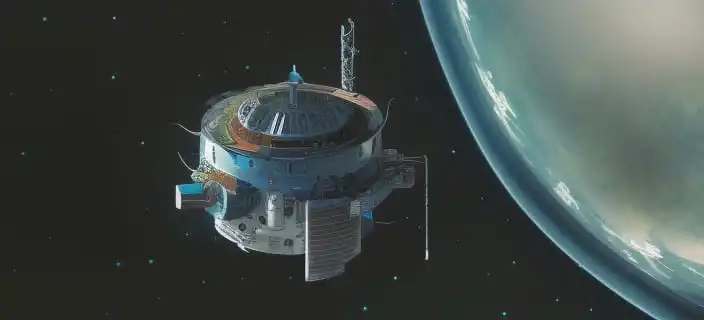As space exploration becomes an increasingly important aspect of scientific research and discovery, developing technology to simulate gravity is critical to ensure the health and safety of astronauts on long-duration missions. One of the most well-known examples of a centrifugal force system is the Gravitron ride, found in many amusement parks. While the Gravitron ride is designed purely for entertainment purposes, the same principles that allow it to generate artificial gravity can be adapted for use in artificial gravity systems.
In this blog post, we’ll take an inside look at how Gravitron technology is developed and tested for use in artificial gravity systems, discussing the research and development process and how it compares to the development of other artificial gravity systems. We’ll explore the key challenges involved in developing artificial gravity, the types of tests used to refine the technology, and the role that Gravitron technology can play in accelerating the development of artificial gravity systems.
- How Gravitron technology is adapted for artificial gravity?
- The research and development process
- Proposals
- The role of Gravitron technology in artificial gravity development
- FAQ
- Conclusion
How Gravitron technology is adapted for artificial gravity?
Gravitron technology is a type of centrifugal force system that can be adapted for use in artificial gravity systems. The basic principle behind the Gravitron ride is that the circular motion of the ride generates a centrifugal force that pushes riders outward and simulates the effect of gravity. The faster the ride spins, the stronger the centrifugal force, and the more intense the simulated gravity.

In order to adapt Gravitron technology for artificial gravity systems, engineers must consider a variety of factors, including the size and shape of the structure, the materials used, and the speed and direction of the spinning motion. Artificial gravity systems must be designed to produce a consistent and sustainable gravitational force that mimics the effects of Earth’s gravity, typically around 9.8 m/s^2.
Type 1
One way that Gravitron technology is adapted for artificial gravity is by increasing the size of the structure and the speed of the spinning motion. This allows for a stronger centrifugal force and a more intense simulated gravity. However, increasing the size and speed of the structure also requires more energy and can present engineering challenges related to stability, safety, and comfort.
Type 2
Another way that Gravitron technology can be adapted for artificial gravity is by changing the shape of the structure. For example, an artificial gravity system could consist of a series of concentric rings that spin around a central hub. This would allow for a more even distribution of gravitational force and would be more space-efficient than a larger, cylindrical structure.
The research and development process
The research and development process for artificial gravity systems involves a multi-disciplinary approach that draws on physics, engineering, and medical expertise. The goal of this process is to create a system that can generate a consistent and sustainable gravitational force that simulates the effect of Earth’s gravity.
The first step
The first step in the research and development process is to conduct theoretical and computational modeling. This involves using mathematical equations and computer simulations to predict the behavior of the system under different conditions. Theoretical and computational modeling can help engineers to identify potential challenges and refine the design of the artificial gravity system before any physical prototypes are built.

2nd Step
Once the theoretical design has been refined, the next step is to build physical prototypes and conduct experiments in laboratory settings. This involves testing the system under a range of conditions, including different spin speeds, directions, and angles. The goal of these experiments is to identify any design flaws or safety concerns and to refine the system until it is capable of producing a consistent and sustainable gravitational force.
3rd Step
After laboratory testing, the next step is to test the artificial gravity system in a reduced-gravity environment, such as aboard the International Space Station or in parabolic flight. This allows engineers to test the system under conditions that are more similar to those experienced by astronauts in space. Testing in reduced-gravity environments can help engineers to refine the system further and ensure that it is safe and effective for use in space.
Proposals
There have been several proposals for space structures using centrifugal force to simulate gravity, each with their own unique designs and features. Some of the most notable proposals include:

- Stanford torus: This design, proposed by NASA in the 1970s, consists of a large torus-shaped ring that rotates to create a simulated gravity environment. The torus would be about one mile in diameter and house up to 10,000 people.
- O’Neill cylinder: Proposed by physicist Gerard O’Neill in the 1970s, this design is essentially a cylindrical tube that rotates around its long axis to create artificial gravity. The cylinder would be about 20 miles long and 5 miles in diameter, and could potentially house up to 1 million people.
- Bernal sphere: This design, proposed by British scientist John Desmond Bernal in the 1920s, is a hollow sphere that rotates to create a simulated gravity environment. The sphere would be about 16 kilometers in diameter and could potentially house millions of people.
- Kalpana One: This is a more recent proposal for a rotating space habitat that could be built using current technology. The design is based on the O’Neill cylinder and would house up to 20,000 people, with living quarters, workspaces, and recreational areas arranged along the interior of the cylinder.
The role of Gravitron technology in artificial gravity development
Gravitron technology can play an important role in the development of artificial gravity systems. Gravitron technology uses centrifugal force to create a simulated gravity environment for testing purposes, making it an ideal tool for testing and refining artificial gravity systems.
- One way that Gravitron technology can be used is to simulate the gravitational environment of other planets or moons. By adjusting the rotation rate of the Gravitron, scientists can create an artificial gravity environment that simulates the gravitational force on a specific planet or moon. This allows researchers to test the effects of different gravitational forces on human health and performance, as well as to develop and test technologies that can function in different gravitational environments.
- Another way that Gravitron technology can be used is to refine the design of artificial gravity systems. By testing different types of artificial gravity systems in the Gravitron, researchers can evaluate the effectiveness of each system and make improvements based on the results. For example, they can test different materials and shapes for rotating habitats, or evaluate the effectiveness of different exercise regimes in mitigating the negative effects of microgravity.
- In addition to testing and refining artificial gravity systems, Gravitron technology can also be used to study the physiological effects of gravity on the human body. By exposing subjects to different simulated gravity environments, researchers can study the effects of artificial gravity on bone and muscle loss, cardiovascular function, and other aspects of human health.

FAQ on Gravitron: Artificial Gravity Technology
Can centrifugal force simulate gravity in space?
Yes, centrifugal force can simulate gravity in space by generating a force similar to gravity. This can be achieved by rotating a spacecraft or space station, where the centrifugal force generated by the rotation creates a simulated gravity environment for the occupants.
How does centrifugal force relate to gravity?
Centrifugal force is a force that is felt by objects in motion, such as those on a rotating platform. This force is perpendicular to the direction of motion and can create a simulated gravity environment. Gravity, on the other hand, is a natural force that is caused by the mass of objects attracting each other. While these two forces are not the same, the use of centrifugal force can simulate the effects of gravity.
Is it possible for astronauts to experience artificial gravity in space?
Yes, it is possible for astronauts to experience artificial gravity in space by using methods such as rotating spacecraft or space stations, or by using other technologies such as linear accelerators.
Can NASA create artificial gravity?
NASA is actively researching and developing artificial gravity technologies, including the use of rotating spacecraft or space stations. However, creating artificial gravity in space presents a number of technical and engineering challenges, and more research and development is needed before it can be implemented.
What is the problem with space station artificial gravity physics?
One problem with space station artificial gravity physics is that the amount of simulated gravity generated by rotating a space station is directly related to the radius of the rotation. This means that a larger radius is needed to generate the same amount of simulated gravity, which presents challenges in terms of the size and weight of the spacecraft, as well as the cost and feasibility of launching it into space. Additionally, the physiological effects of artificial gravity may not be fully understood, and more research is needed to better understand the impact of simulated gravity on the human body.
Conclusion
In conclusion, Gravitron technology offers a unique opportunity to develop and test artificial gravity systems. The use of centrifugal force to create a simulated gravity environment allows researchers to study the physiological effects of gravity and test different artificial gravity systems in a controlled and reproducible manner. Despite past setbacks, to develop an artificial gravity system, recent advancements in technology and research have brought us closer than ever before to achieving artificial gravity for long-duration spaceflight. By continuing to develop and refine artificial gravity systems with the help of Gravitron technology, we can pave the way for human exploration and settlement of space in the future.


